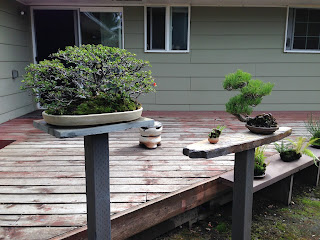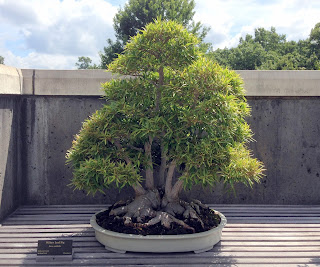Friday, July 29, 2016
We've relocated!
This blog will be continued on my new site - Buckstone Bonsai. Just select the Branch Work tab. If you'd like to receive news and notifications regarding new blog posts, please select the Contact tab and join the mailing list. Thanks for reading!
Thursday, October 22, 2015
Branch and Trunk Bending Techniques (Part Two)
This time the subject at hand is a collected Rocky Mountain Juniper that Todd collected in 2012, firmly established and ready for work. This tree features a nice trunk that is mostly deadwood and a strong branch growing near it, which the crown could be built on, but what is the challenge in that?
There is a long protruding branch on the rear side of the tree that terminates several feet away from the trunk, which has nice movement and could serve as the apex. Our mission is to re-position this branch so that it apexes over the trunk. This bend would be even more challenging than the Limber Pine in part 1 since it's very thick and not as flexible.
There appeared to be two veins feeding this branch at one time and one was mostly dead, so we opted to split the branch and remove this section.
After the section is removed, it's time to level the area.
The area is then lined with gauge 4 copper wire and wrapped in raffia.
A piece of rebar is positioned in the soil tied to secure large jack/branch bender. The jack is then secured on several pieces of deadwood.
The branch set in its final position for the day. In the spring, we'll split the base of the branch in order to eliminate the straight portion next to the trunk.
Friday, October 9, 2015
The Artisans Cup 2015
It was indeed an honor to be chosen as one of the exhibitors at the inaugural Artisans Cup. The tree I exhibited was a Korean Hornbeam, purchased several years ago at auction from a private collection in the US. I
was told it was developed in Japan before importing to the states. It’s one of the more stately trees in my
garden and I feel very fortunate to be its current caretaker. I staged the setup and snapped these photos shortly before it left for Portland. It was just beginning to display some yellow fall color...
Here is the tree and accent in place and ready for fitting in one of the cross-country transport trucks. Thanks again to volunteer and driver, Russell Baggert, who ensured the trees safely arrived to and fro.
Up next on the tour was a visit to Michael Hagedorn's garden. I enjoyed meeting Michael and getting to know the crew from the Portland Bonsai Village. Such a beautiful array of yamadori from the area, including the clumps of Mountain Hemlock and Vine Maple. I enjoyed the collection of kusamono on hand as well.
That evening came the opening of the exhibition at the Portland Art Museum. I had grabbed a bite to eat a few blocks down from the museum and came outside to the sound of drums to mark the opening. The exhibit was nothing less than spectacular and brilliantly conceived, from the poetic passages to the intricate lighting.
I located the hornbeam nestled between one of the massive trees from the Pacific Bonsai Museum, a Japanese Black Pine, and John Kirby's California Juniper.
After the wonderful brunch and awards celebration on Sunday morning at Departure restaurant, I hopped on a bus trip to Bonsai Mirai with my friends and travel companions from Nebraska, Stephanie Walker and Scott Luke. Ryan's garden was a little slice of heaven on earth. I hope to return soon.
Saturday, August 15, 2015
North Carolina Arboretum's Bonsai Exhibition Garden
I was fortunate to visit the NC Arboretum in Asheville last weekend. The Bonsai Exhibition Garden is one of their most visited permanent exhibits. The Garden is very well conceived - the mixture of stone and wood complement the bonsai very well. One of the more unique compositions is named Appalachian Cove, which is a mixture of native trees planted in an old wooden box. It's the bonsai version of the Blue Ridge Parkway. It included a very refined hollow-trunk American Hornbeam, which had unbelievable leaf reduction. It almost looked like an elm. I also thought the mixed planting of American Beech and Eastern Hemlock was a unique effort. It would be interesting to know more of the history surrounding these trees, including all of the pot makers. Enjoy the tour!
Subscribe to:
Comments (Atom)






















































































